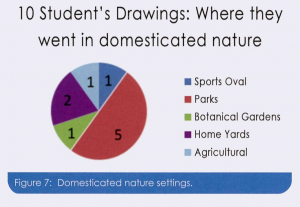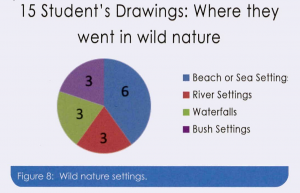Overview
In 2013, educational researchers at the University of Southern Australia – Marj Fracis, Kathy Paige, and David Lloyd were interested in learning more about middle years’ students’ experiences in nature. Therefore, they decided to engage in a small scale case study. Marj was inspired by her own nature experiences in childhood and how that developed into her personal passion for environmental science. They were also influenced by the sweeping educational movement in Australia towards place-based learning (PBL) practices when teaching to help cultivate safe, positive, and healthy learning opportunities for students.
Unfortunately, they had been noticing that “increasingly, children today are becoming disconnected from the natural environments resulting in a diminished sense of self, place, and community” (Francis, Paige, & Lloyd, 2013). For a variety of reasons, students are having fewer direct experiences in natural environments, which can have negative impacts on their health, concentration, creativity, and sense of well-being.
They first started noticing during their pre-service teaching that not all students respond to learning in natural environments with positive attitudes or enthusiasm, which affects the effectiveness of the PBL approach to learning initiatives. This lack of connection and identification with the natural world around them is “likely to impact the most heavily on decisions, planning and design of human settlements which continue to place a greater strain on the ongoing natural and physical systems that enable the Earth to maintain life, challenging the sustainability of the natural world” (Francis et al., 2013). Therefore, there is a worry that if students do not develop a committed and connected relationship to nature, they will not take measures to protect from further decline in the future.
This specific case study focuses on the ways in which children play and experience natural environments during free-time activities. Its aim is to inform place and community-based learning practices that will create better nature-based opportunities for children and young people in the community It has been shown that learning is strongly connected to play and it’s important to know how students’ initial experiences are shaping their perceptions, ideas, attitudes, and concepts about nature (Francis et al., 2013). According to another researcher in the field, when children engage with natural play environments, there are seven ways in which they will direct the play: adventure, fantasy/imagination, animal allies, exploration, creation of a special place, and creation of small worlds (Sobel, 2008).
This study was conducted within a project called ‘Citizen Science: Urban Ecology Network in the School of Educational Aspirations Project [SEAP]. Participants in this case study were twenty-five year six and seven students within one classroom in a SEAP school (Francis et al., 2013). The class moved through this case study in two phases. Phase one began with a drawing activity which included a place in nature, how they used the outdoor space, who shared the experience with them, any animals or creatures also in the space, and what manmade structures (if any). In addition to the drawing there was an open ended questionnaire portion of phase one. In phase two, only a small portion (seven) of the students, were involved in focus group interviews (Francis et al., 2013).
In order to sort the qualitative data, the drawings were classified into two main categories: domesticated and wild nature settings. See examples of the difference between domesticated and wild nature settings below.


Overall, according to this small sample size, “wild nature settings were preferred as subjects for drawing and sharing experiences about nature experiences (15) over domesticated nature settings (10) – with some students expressing concern and reluctance to include domesticated nature settings when comparing their own experiences to peers” (Francis et al., 2013). The difference between the two nature settings becomes more notable when considering how students accessed nature experiences and the types of activities in which students engaged in. The majority of students accessed nature experiences as semi-structured outings or family gatherings at places of interest or for specific purposes (Francis et al., 2013). These activities were mostly directed by adults (e.g. bushwhacking, sight-seeing, exploring, fishing, camping, playing ball, etc.). This finding reveals that there is a heavy reliance on families to transport students to spaces and place where they can engage in what they value, as a nature experience. During these activities, play tended to be organized and supervised by adults. It also shows a lock of opportunities for creative and imaginative play in nature. However, this study also showed that students have an awareness and empathy towards nature; they understand the risks that the world is facing and the impact humans are having on it (e.g. concerns of animal extinction) (Francis et al., 2013).
My Story and Connection to this Topic
For the past five years I have taught a combined grade two and three class. Recent research has noted the positive impacts of play for young learners. Therefore, I have been incorporating into my practice more and more. But I have noticed that some students have a difficult time engaging in ‘free-play’ and need frequent opportunities to practice. Each year I have also noticed that when I take students outside, there are a growing percentage who do not know how to ‘play’ outside. They are unsure how or what to play and some are disgusted by the thought of being dirty. I understand that not all students enjoy being outside, but where does that feeling or thought come from? In North Vancouver, B.C. we are extremely lucky because we are surrounded by nature all the time. We have mountains on one side and ocean on the other. Therefore, I find it difficult to comprehend why some students are not engaging with nature. And why are other students becoming disconnected with the natural environments around them? There are so many different variables that could contribute to this change in environmental identity – technology, culture, parenting styles, socio-economic status, and more.
In addition, I have noticed students more engaged in technology outside of the classroom and in the home. Information comes out at sharing time as well as trickling back into the classroom when their morning discussions revolve around a video, song, game, or app they have been engaging with. I reflect back on my childhood and I remember playing outside in the cul-de-sac with neighbours for hours until it was time for dinner. I remember having our family computer in the common area and having a time limit for our use. Technology and outdoor education seem to be on opposite sides of the education spectrum. What I want to know more about is how families, communities, and educators can get to a place where there is a balance of the two, especially in the middle years.
Area of Interest, Research Problem, Purpose, and Questions
This year I am transitioning out of the primary grades and into intermediate in my urban elementary school. However, there are some aspects of primary education that I believe would be extremely beneficial for intermediate students as well. One of these areas is play. I am hoping to look at how to effectively balance outdoor education with educational technology instead of it being one or the other, or that overexposure to one is to the detriment of the other. This is important in order to develop students into a well-rounded individuals who have a strong sense of environmental identity, as well as develop critical thinking and problem solving strategies through the use of educational technology tools and applications. Some of the questions that I am starting to consider on this topic are:
-
- Is there evidence of the increased use of technology for students, as a factor of the decrease in a lack of environmental identity?
- How can you effectively engage middle years’ students in outdoor play?
- How can you incorporate grade-level curricular learning outcomes into outdoor play?
- How can you use educational technology resources to capture and report on the learning in an outdoor play setting?
More to explore on the topic
Journal Articles
Role of Significant Life Experiences in Building Environmental knowledge and Behaviour Among Middle School Students by K. Stevenson, M. Peterson, S. Carrier, R. Strnad, H. Bondell, T Kirby-Hathaway & S. Moore (2014)
The home electronic media environment and parental safety concerns: relationships with outdoor time after school and over the weekend among 9-11 year old children by H. Wilkie, M. Standage, F. Gillison, S. Cumming, & P. Katzmarzyk (2017)
Design for Play: A guide to creating successful play spaces by A. Shackell, P. Doyle, N. Butler, & D. Ball (2008)
Play, Learning and the Early Childhood Curriculum by E. Wood & J. Attfield (2005)
The importance of outdoor play for young children’s healthy development by G. Bento & G. Dias (2017)
Contrasting Screen-Time and Green-Time: A Case for Using Smart Technology and Nature to Optimize Learning Processes by R. Schilhab, M. Stevenson, & P. Bentsen (2018)
New concepts of play and the problem of technology, digital media, and popular culture integration with play-based learning in early childhood education by S. Edwards (2015)
Place Based Learning and Inquiry in a Digital Culture: Honouring Student Voice Through Digital Storytelling by M. Sauerborn (2015)
Teacher Resources
http://www.metrovancouver.org/events/school-programs/K12publications/GetOutdoors.pdf
http://resources4rethinking.ca/media/B2N_Into-Nature_English.pdf
Student Activities
-nature walk with camera or plant guide
-scavenger hunt
-plant identification apps
-digital recording device
-digital microscope
-BookCreator for stories
Experts in my #PLN
Twitter Instagram
@msflett the.nature.atelier
@Roomtoplay opalschoolportland
@CreativeSTAR natureplaykids_
@SylviaMarieKing nurturing_with_nature
#outdoored
#outdoorlearning
Blogs Posts
-Creating Tomorrow’s Entrepreneurs through Outdoor Ed
-Getting kids outdoors with tech
Other
Movie – https://www.imdb.com/title/tt1567665?ref_=vi_close
Resources
Francis, M., Paige, K., & Lloyd, D. (2013). Middle years students’ experiences in nature: A case study on nature-play. Teaching Science: The Journal of the Australian Science Teachers Association, 59(2), 20–30.
Sobel, D. (2008). Childhood and Nature: Design Principles for Educators. Stenhouse Publishers.
Recent Comments